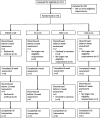Effects of simultaneous cognitive and aerobic exercise training on dual-task walking performance in healthy older adults: results from a pilot randomized controlled trial
- PMID: 32122325
- PMCID: PMC7052975
- DOI: 10.1186/s12877-020-1484-5
Effects of simultaneous cognitive and aerobic exercise training on dual-task walking performance in healthy older adults: results from a pilot randomized controlled trial
Abstract
Background: The ability to walk and perform cognitive tasks simultaneously is a key aspect of daily life. Performance declines in these dual-tasks may be associated with early signs of neurodegenerative disease and increased risk of falls. Thus, interventions to improve dual-task walking performance are of great interest for promoting healthy aging. Here, we present results of a pilot randomized controlled trial (RCT) to evaluate the effects of a simultaneous aerobic exercise and cognitive training intervention on dual-task walking performance in healthy older adults.
Methods: Community-dwelling, healthy older adults were recruited to participate in a 12-week RCT. Participants were randomized into one of four groups (n = 74): 1) cognitive training (COG), 2) aerobic exercise (EX), 3) combined aerobic exercise and cognitive training (EXCOG), and 4) video-watching control (CON). The COG and EXCOG groups both used a tablet-based cognitive training program that challenged aspects of executive cognitive function, memory, and processing speed. Performance on a dual-task walking test (DTWT; serial subtraction during two-minute walk) was assessed by researchers blinded to groupings before the intervention, and at 6 and 12 weeks. We included all participants randomized with baseline measurements in an intention to treat analysis using linear mixed effects models.
Results: We found a significant group by time interaction for cognitive performance on the DTWT (p = 0.039). Specifically, participants in the EXCOG, EX, and COG groups significantly improved on the cognitive aspect of the DTWT following the full 12-week intervention (p = 3.5e-7, p = 0.048, p = 0.048, respectively). The improvements in EXCOG were twice as large as in the other groups, and were significant at 6 weeks (p = 0.019). The CON group did not show a significant change in cognitive performance on the DTWT, and no group significantly altered dual-task gait measures following the intervention.
Conclusions: A simultaneous aerobic exercise and cognitive training intervention significantly improved cognitive performance during a DTWT in healthy older adults. Despite no change in DTWT gait measures, significant improvements in cognitive performance indicate that further investigation in a larger RCT is warranted.
Trial registration: Clinicaltrials.gov, NCT04120792, Retrospectively Registered 08 October 2019.
Keywords: Aging; Cognition; Executive function; Exergame; Physical activity.
Conflict of interest statement
The authors declare that they have no competing interests.
Figures


References
-
- Bruderer-Hofstetter M, Rausch-Osthoff A-K, Meichtry A, Münzer T, Niedermann K. Effective multicomponent interventions in comparison to active control and no interventions on physical capacity, cognitive function and instrumental activities of daily living in elderly people with and without mild impaired cognition–a systematic review and network meta-analysis. Ageing Res Rev. 2018;45:1–14. doi: 10.1016/j.arr.2018.04.002. - DOI - PubMed

